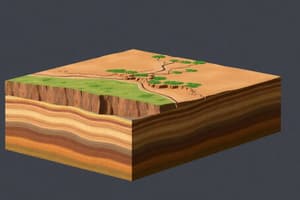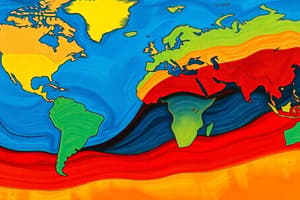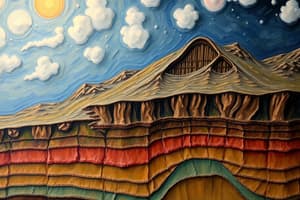Podcast
Questions and Answers
What is the primary composition of the continental crust?
What is the primary composition of the continental crust?
- Iron and magnesium (correct)
- Magma and nickel
- Silicate and aluminum
- Olivine and granite
Which layer of the Earth is defined as the only liquid form layer?
Which layer of the Earth is defined as the only liquid form layer?
- Outer core (correct)
- Mantle
- Crust
- Inner core
What layer contains the magma chamber?
What layer contains the magma chamber?
- Outer core
- Inner core
- Mantle (correct)
- Crust
What is the average thickness of oceanic crust?
What is the average thickness of oceanic crust?
Which discontinuity marks the boundary between the crust and the mantle?
Which discontinuity marks the boundary between the crust and the mantle?
What characterizes the inner core of the Earth?
What characterizes the inner core of the Earth?
What is the primary use of a seismometer?
What is the primary use of a seismometer?
How thick is the mantle compared to other layers of the Earth?
How thick is the mantle compared to other layers of the Earth?
What measurement quantifies the amount of energy released from the focus of an earthquake?
What measurement quantifies the amount of energy released from the focus of an earthquake?
Which earthquake type occurs when the subducting slab is deeper than 70 km into the mantle?
Which earthquake type occurs when the subducting slab is deeper than 70 km into the mantle?
What is the term for the point on the Earth's surface directly above the focus of an earthquake?
What is the term for the point on the Earth's surface directly above the focus of an earthquake?
Which type of earthquake follows the main shock and is characterized by aftershocks?
Which type of earthquake follows the main shock and is characterized by aftershocks?
What kind of earthquake is associated with faults, volcanic activity, and nuclear tests?
What kind of earthquake is associated with faults, volcanic activity, and nuclear tests?
What are the characteristics of P Waves?
What are the characteristics of P Waves?
Which type of wave primarily causes the most damage during an earthquake?
Which type of wave primarily causes the most damage during an earthquake?
What is the primary flaw in Alfred Wegener's theory of continental drift?
What is the primary flaw in Alfred Wegener's theory of continental drift?
Which of the following statements accurately describes a characteristic of surface waves?
Which of the following statements accurately describes a characteristic of surface waves?
What did Harry Hess primarily propose related to plate movements?
What did Harry Hess primarily propose related to plate movements?
What does 'Panthalassa' refer to in the context of Pangaea?
What does 'Panthalassa' refer to in the context of Pangaea?
What type of motion do Love Waves exhibit?
What type of motion do Love Waves exhibit?
Which of the following statements about S Waves is correct?
Which of the following statements about S Waves is correct?
What is the PHIVOLCS Earthquake Intensity Scale used for?
What is the PHIVOLCS Earthquake Intensity Scale used for?
Which country has the most recorded earthquakes worldwide?
Which country has the most recorded earthquakes worldwide?
What was the magnitude of the earthquake that struck Christchurch, New Zealand, on February 22, 2011?
What was the magnitude of the earthquake that struck Christchurch, New Zealand, on February 22, 2011?
What was the casualty count of the Luzon earthquake that struck the Philippines in 1990?
What was the casualty count of the Luzon earthquake that struck the Philippines in 1990?
What significant event occurred during the eruption of Mt. Pinatubo in 1991?
What significant event occurred during the eruption of Mt. Pinatubo in 1991?
Which volcano’s most violent eruption occurred on February 1, 1814?
Which volcano’s most violent eruption occurred on February 1, 1814?
When did the notable eruption of Taal Volcano occur, characterized by 26 recorded shocks?
When did the notable eruption of Taal Volcano occur, characterized by 26 recorded shocks?
What geological feature is commonly referred to as the 'Ring of Fire'?
What geological feature is commonly referred to as the 'Ring of Fire'?
What is the safest action to take if separated from family or friends after a tsunami?
What is the safest action to take if separated from family or friends after a tsunami?
Which of the following actions should be avoided after a tsunami?
Which of the following actions should be avoided after a tsunami?
What precaution should be taken before a volcanic eruption?
What precaution should be taken before a volcanic eruption?
During an active volcanic eruption, what should you do if caught outdoors?
During an active volcanic eruption, what should you do if caught outdoors?
What should you wear during an ash fall to protect yourself?
What should you wear during an ash fall to protect yourself?
What is a recommended action if you are trapped outdoors during a volcanic eruption?
What is a recommended action if you are trapped outdoors during a volcanic eruption?
After a volcanic eruption, why should you avoid driving in heavy ash fall?
After a volcanic eruption, why should you avoid driving in heavy ash fall?
What should you do if you have a respiratory ailment after a volcanic eruption?
What should you do if you have a respiratory ailment after a volcanic eruption?
Flashcards are hidden until you start studying
Study Notes
Layers of the Earth
- Lithosphere: crust and uppermost mantle, comprised of tectonic plates
- 4 Major Layers:
- Crust: where life exists, composed of tectonic plates, rich in iron and magnesium
- Continental Crust: makes up the continents, 30 - 50 km thick
- Oceanic Crust: underlies the ocean floor, average thickness of 10 km
- Mantle: semisolid, rocky, very hot, 2,900 km thick (80% of Earth's mass), composed of olivine and silicate rich rocks, temperature of 200°c to 4000°c
- Outer Core: liquid, molten nickel and iron, radius of 2,260 km thick, temperature of 3,700°c to 4,300°c
- Inner Core: solid, diameter of 1,220 km thick, composed of solid iron and nickel, 8,100°F to 14,000°F, gives the planet its magnetic field
- Crust: where life exists, composed of tectonic plates, rich in iron and magnesium
- Interfaces:
- Mohorovicic Discontinuity ("Moho"): boundary between crust and mantle
- Gutenberg Discontinuity: boundary between mantle and outer core
- Lehman Discontinuity: boundary between liquid outer core and solid inner core
Mapping the Inner Earth
- Seismometer: detects ground motions from events like earthquakes, volcanic eruptions
- Seismograph: records seismic waves
Seismic Waves
- Body Waves: travel through the inner layers of Earth, arrive first
- P Waves ("Primary Waves"): first to be felt, travel 1.5 to 8 km/s, shake ground horizontally
- S Waves ("Secondary Waves"): transverse waves, move up and down perpendicular to direction of travel, do not travel through liquids
- Surface Waves: travel on Earth's surface (crust), felt later, cause greater damage
- Love Waves: fastest, move ground side to side
- Rayleigh Waves: circular motion, similar to rolling, combine all wave movements, cause buildings to heave
Pangaea
- Supercontinent: "all lands", existed millions of years ago
- Panthalassa: surrounding waters, meaning "all seas"
- Continents that made up Pangaea:
- Africa
- Antarctica
- South America
- Australia
- Asia
- North America
- Europe
- Subcontinent (India)
Continental Drift Theory
- Proposed by Alfred Wegener in 1912
- Asserted the existence of Pangaea, which split apart into continents that still move today
- Proposed continents move 15mm per year, but theory was rejected due to lack of explanation for the movement mechanism
- Later, theory gained traction with the discovery of evidence like matching rock formations on different continents
Sea Floor Spreading Theory
- Proposed by Harry Hess
- Describes the spreading of the seafloor and the creation of new crust at mid-ocean ridges
- The theory explained how continents move, carrying the continents on the spreading ocean floor
Theory of Plate Tectonics
- Combines continental drift and seafloor spreading theories
- Explains the movement of the Earth’s lithosphere through a system of plates
- The theory explains the formation of mountains, earthquakes, and volcanoes
Major Tectonic Plates
- Primary Plates:
- Eurasian Plate
- Australian Plate
- Pacific Plate
- North American Plate
- South American Plate
- African Plate
- Secondary Plates:
- Juan de Fuca Plate
- Nazca Plate
- Cocos Plate
- Caribbean Plate
- Philippine Plate
- Arabian Plate
Mountain Ranges in the Philippines
- Formed by the collision of tectonic plates, creating folds and thrusts in the Earth's crust
- Specific mountain ranges mentioned:
- Central Cordillera: Luzon
- Zambales Mountains: Luzon
- Sierra Madre: Luzon
Ocean Trenches
- Deepest parts of the ocean
- Located near continental shelves or volcanic island chains (volcanic arcs)
- Examples:
- Challenger Deep: deepest point on Earth, located in the Mariana Trench
- Puerto Rico Trench: deepest part of the Atlantic Ocean
Earthquakes
- Caused by the release of energy stored in the lithospheric rocks, due to movement of faults, volcanic activity, landslides, mining, and nuclear testing
- Aftershocks: earthquakes that occur after a main shock
- Foreshocks: first earthquakes, usually smaller than the main shock
- Hypocenter (Focus): point within Earth where earthquake rupture starts
- Epicenter: point directly above the focus on Earth's surface
- Types based on focus:
- Shallow Focus Earthquake: less than 70 km deep
- Deep Focus Earthquake: deeper than 70 km
- Magnitude: amount of energy released from earthquake focus, measured by the Richter Magnitude Scale
- Intensity: strength of shaking at a specific location, measured by the Mercalli Intensity Scale
- PHIVOLCS (Philippine Institute of Volcanology and Seismology): developed the PHIVOLCS Earthquake Intensity Scale (PEIS) to measure impact of earthquakes in the Philippines
- Ring of Fire: area around the Pacific Ocean with high volcanic and seismic activity, encompassing:
- Chile
- Mexico
- United States
- Antarctica
- Russia
- Japan
- Philippines
- Guatemala
- New Zealand
- Papa New Guinea
- Indonesia
- Canada
- Peru
- Taiwan
Notable Earthquakes
- Christchurch, New Zealand (2011): 6.3 magnitude, 185 deaths, 1,500–2,000 injuries
- Japan (2011): 9.0 magnitude, 19,759 deaths, 6,242 injured, 2,553 missing
- Luzon, Philippines (1990): 7.7 magnitude, 1,621 deaths, 3,513 injured, 321 missing, 126,035 displaced
Volcanic Eruptions
- Mt. Pinatubo (1991): second-largest eruption of the 20th century, significant ashfall and lahars (mudflows)
- Mayon Volcano (1814): most violent eruption, 1,200 deaths, including the destruction of the town of Cagsawa
- Taal Volcano (1911): devastating eruption, significant volcanic shocks and tremors.
Tsunamis
- Large waves caused by a disturbance in a body of water, often triggered by earthquakes, volcanic eruptions, or landslides
- After Tsunami:
- Stay informed with official updates
- Contact family and friends to ensure their safety
- Avoid floodwaters due to contamination
- Beware of electrocution
- Avoid entering damaged buildings
Precautionary Measures for Volcanoes
- Before:
- Learn about community warning systems and emergency plans
- Have an emergency disaster plan
- Keep a disaster supply kit
- Stay away from active volcano sites
- Be prepared for hazards: mudflows, flash floods, landslides, rock falls, earthquakes, ashfall, tsunamis
- During:
- Follow evacuation orders issued by authorities
- Avoid areas downwind from the volcano
- Keep car engines off
- Avoid ashfall
- Close windows and doors
- Seek shelter indoors
- Protect yourself from rockfalls, mudflows, ashfall
- After:
- Avoid ashfall
- Clear roofs of ash
- Avoid driving in heavy ash
- Protect yourself from ashfall while outdoors
- Help neighbors who need assistance
Studying That Suits You
Use AI to generate personalized quizzes and flashcards to suit your learning preferences.




